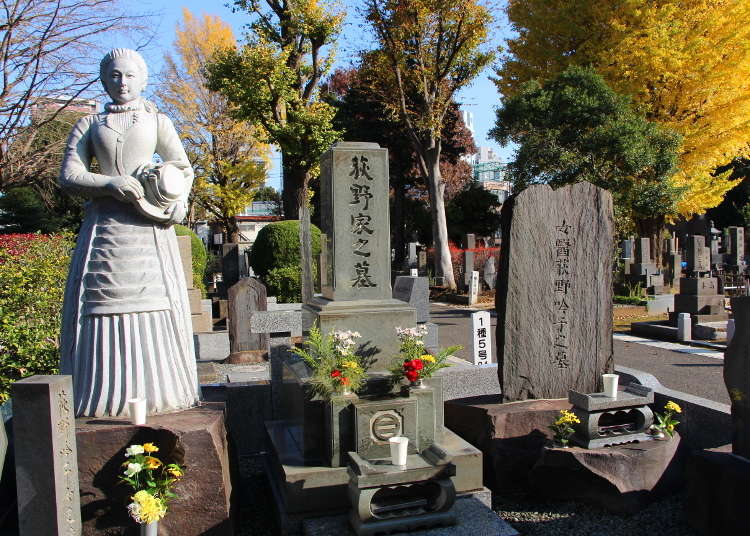
As I gazed over the wide area that sprawled in front of me, both headstones and trees of various colors stretching toward the Tokyo’s clear autumn sky while the morning sun was dipping the scenery in a golden light, I was reassured of two things. Firstly, yes, cherry blossoms are nice, but my absolutely favorite season in Japan is autumn. Secondly: it was absolutely worth getting up early in the morning to visit one of Tokyo’s second largest public graveyard, Zoshigaya Cemetery.
Digging my hands into the warm pockets of my jacket, I silently stood at the entrance for a minute or two, enjoying the sun’s warmth against the cool November breeze while taking in the wild beauty of Zoshigaya Cemetery. A cat mewled to my right and, having been lost in thought, almost made me jump. It examined me skeptically for a moment or two before disappearing towards the headstones. I smiled involuntarily – was this Zoshigaya Cemetery’s way of welcoming me?
The Past and Present of Zoshigaya Cemetery
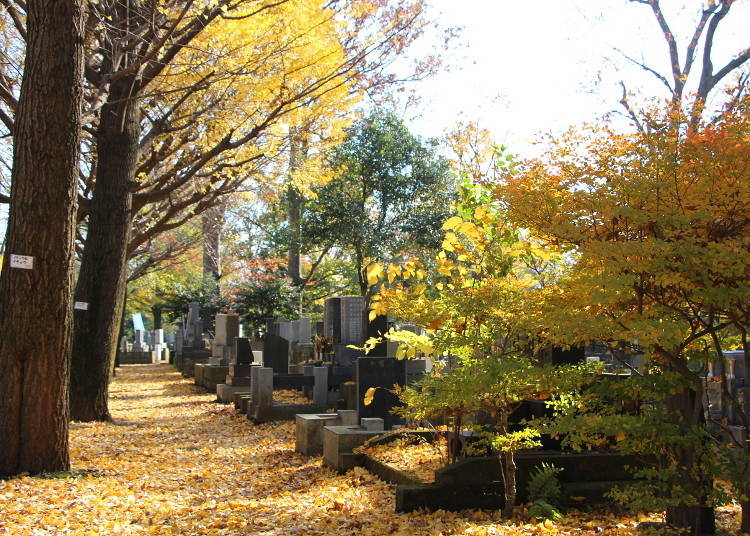
I wasn’t going to discover the many secrets of the graveyard all by myself, however. Zoshigaya locals offer volunteer guide services for personal tours and I was more than ready to turn around every stone in this stunning place, uncovering the rich history that rests not only in the graves themselves. Zoshigaya Cemetery is the public graveyard and created by the Meiji Government in 1874. Looking over the area, it is hard to imagine that the graveyard is not even 200 years old – with its thousand nooks and crannies, gnarly trees, and countless headstones, it looks like an ancient, enigmatic place right out of a fairy tale.
The ground, covered in golden ginkgo leaves, felt pleasantly soft under my soles as we soon strayed from the narrow gravel path leading through the graves to venture deeper into the bellies of the different segments. I’ve visited Tokyo’s other major cemeteries, the famous Aoyama and Yanaka cemeteries among them, but Zoshigaya and its beautiful, raw wildness immediately conquered my heart as my new favorite. It was a Wednesday morning and there was not a soul to be seen – it seemed like I had the massive 10 hectare space all to myself, sharing it only with roaming cats and curious crows.
Lafcadio Hearn: The Expat of Yesterday meets the Expat of Today
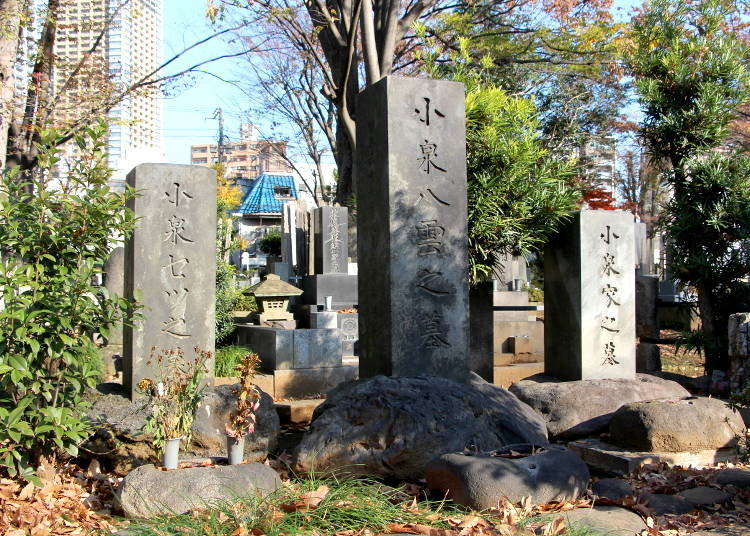
If my guide hadn’t slowed down and come to a halt in front of one of the graves, I would have marched right past it. “Here lies Lafcadio Hearn and his family”, she said and I stared at the simple but elegant characters edged into the stone – and then I remembered. I was well familiar with the name of Lafcadio Hearn, author of Kwaidan: Stories and Studies of Strange Things, a collection of Japanese ghost stories, and Glimpses of Unfamiliar Japan, among other works. While living in Japan, he took the name of Koizumi Yakumo, which were the very characters written on his headstone.
In a time when Japan had just opened its gates to people from overseas, he was the odd one out as a foreigner who didn’t point out what kind of things Japan needs to improve on to catch up to the industrialized Western world, as asked by the Japanese government, but instead was completely dazzled by the local culture. Standing in front of his grave as an immigrant to Japan myself, I couldn’t help but feel a connection to the Irish-Greek expat. Isn’t the desire to discover and experience Japan’s rich culture, vastly different from your own, and ultimately falling in love with it the very reason I thought about him between golden leafs and gravestones on that cold November morning?
By the way: I think that Lafcadio Hearn is mighty pleased to have his Japanese name written on his final resting place rather than his European one. My Japanese guide told me that his Japanese first name, Yakumo, means ‘countless clouds’ and is a reference to the oldest Japanese poem in recorded history, said to have been written by Susanoo, the deity of storms and thunder himself. While someone had left flowers on Koizumi Setsu’s grave, Mr. Hearn’s wife, his own headstone lay rather bare and I promised myself to get something nice for him the next time I’d visit – from one expat to another.
Ginko Ogino: Smiling Confidently over Zoshigaya’s Graves
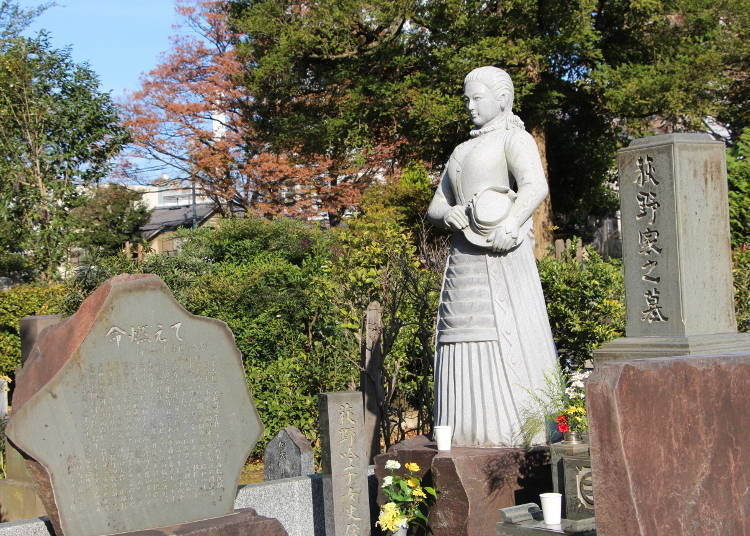
With a last glance I bid goodbye to Koizumi Yakumo and continued my way through Zoshigaya Cemetery. Without my local guide, I’d surely have gotten lost in between the graves and greenery but in all honesty, I don’t think I would have minded. The natural silence and calming atmosphere of the cemetery had me thoroughly enticed. We passed a particularly gnarled tree that seemed to defy the little walkways and marked areas, standing right in the middle of a path and stretching his long branches towards the sky. “Right here”, said my guide and pointed to the defiant tree. “…was a falconry before the area got turned into a cemetery.” Right – this place doesn’t only tell a story about the people being buried here but also speaks of what the land had been used for before. Even nowadays, Zoshigaya Cemetery seems populated by numerous larger birds, the majority of them being crows.
Unlike Lafcadio Hearn’s headstone which didn’t stand out to me at all, I could spot our next destination from several meters away. It was the only grave that was marked by a statue, one you’d expect to find at old European graveyards as well – just that it was lacking wings or any other sort of Christian symbolisms. Instead, a short Japanese woman looked down on me with a confident smirk and a proud posture. I immediately knew who she was without having to lay my eyes on the characters on the headstone. She was none other than Ginko Ogino, the first Japanese woman who graduated in Western medicine and became a doctor.
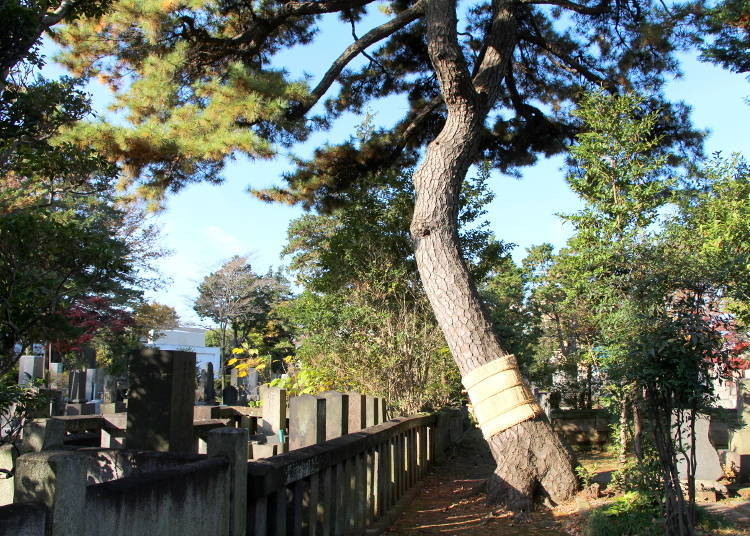
I pressed my hands together and bowed slightly in front of her to pay my respects – and respect do I have, as her story is an amazing one. Married at the tender age of sixteen, she lived as a rich heir’s wife for… actually not very long because shortly after her marriage, her husband infected Ginko with gonorrhea and she promptly divorced him. Since she was Japan’s first female doctor of Western medicine, you can imagine what kind of doctor she had to go see for treatment. A male one, of course. To say that her experience was an unpleasant one is a vast understatement – in fact, having to deal with a disease that was considered shameful, under male treatment, caused Ginko to passionately follow the path of becoming a doctor herself to spare other women from the negative experience she had to make. In a time when women were banned from enrolling in universities, she fought tooth and nail against sexist laws, stereotypes, and preconceptions to eventually emerge as Japan’s first licensed female doctor of Western medicine in 1885. In the same year, she opened her own hospital – the Ogino Hospital – in Tokyo, specializing in obstetrics and gynecology.
Needless to say, I was standing in front of the monument of a pioneer of women’s rights and women’s health. Opposed to Lafcadio Hearn’s final resting place, however, Ginko Ogino’s was generously decorated with fresh flowers. It seemed that even nowadays, people are more than aware of the massive contributions she has not only made in the field of medicine but also for women and their health in Japan. I looked back up at the statue and the hint of a confident smile on her face – and suddenly I was sure that she was well aware of her contributions as well.
Inspired by the Dead: Zoshigaya’s Creative Minds
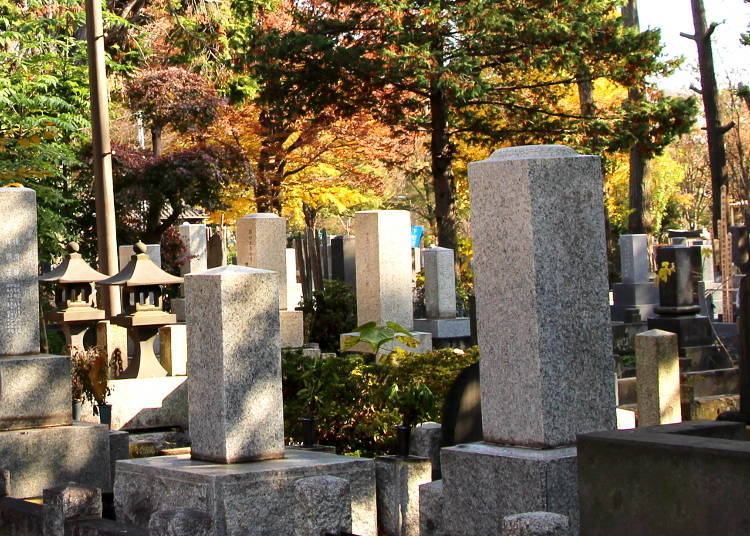
Smiling back at Ginko Ogino for a moment, I bode farewell to her and followed my guide further into the bowels of Zoshigaya Cemetery. We stopped briefly at the gravestones of two famous Japanese artists, both well known for their amazing depictions of women: Yumeji Takehisa and Seiji Togo. I am a fan of particularly the latter and his wonderful style that danced between Japanese aesthetics and French Futurism. It is astounding how many creative minds are buried at Zoshigaya Cemetery, offering the possibility to get as close as possible to the people who keep inspiring us far beyond their lifetime. This is why our next halt was one that I had been looking forward to ever since I entered the large cemetery. I was about to visit the grave of one of the persons who was majorly responsible of my falling in love with the Japanese language.
Natsume Soseki: Of Timeless Melancholy and Disapproving Cats
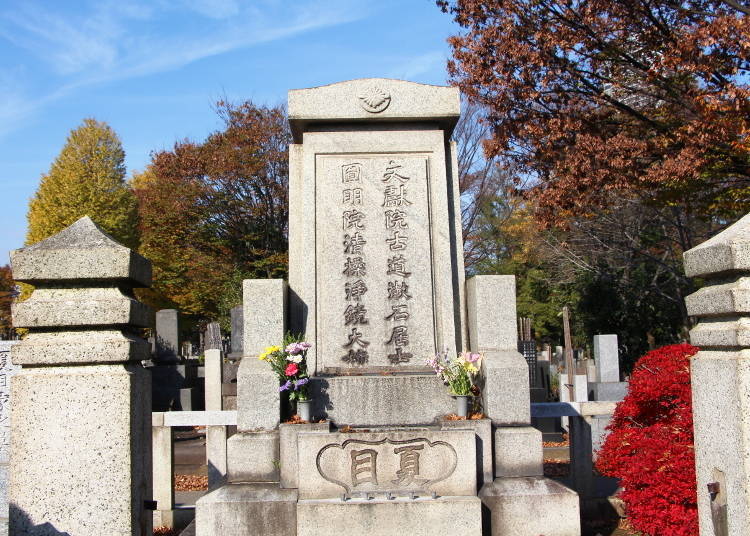
“This is the grave of Natsume Soseki” she said, gesturing to the large, somewhat oddly shaped headstone. It was a beautiful monument, surrounded by vivid red foliage, faintly glistening in the sun. The two characters of his family name were edged beautifully into the stone, an elegant ornament that almost looked like a heart encircling them – which made me smile, as one of his most famous novels is called just that: Kokoro, meaning “heart” in English. The curious shape of his headstone, by the way, is made to resemble a comfortable armchair. The author died of a stomach ulcer and had great pain sitting in the last months of his life, thus leaving his last book unfinished. The chair-like headstone was made in the hopes that Natsume Soseki did find rest and indeed a very comfortable chair in the afterlife.
For the uninitiated: while not as famous as a century ago, Natsume Soseki is one of Japan’s most important novelists And while you might not know the works of Natsume Soseki, you will at least have heard of Haruki Murakami, Japan’s contemporary star author whose books are read all over the world. Well, Haruki Murakami names Natsume Soseki as his favorite writer. Until recently, his face was even printed on Japan’s 1,000 yen note.
But enough about the legacy and more about the person. Natsume Soseki was born in 1867 just before the Meiji restoration, a key point of Japanese history that marked both a rapid industrialization and a drastic reshaping of the Japanese society that turned away from the traditional towards the Western world. Kicking off his literary career in his 30s, he managed to perfectly capture the feelings of the majority of people of a new, industrial Japan – loneliness, poverty, an estrangement with the society around oneself. Using these themes, Soseki watches the world around him through a very personal, melancholic lens that cannot only be applied to the historic setting he lived in but fits almost shockingly well to the challenges our generation faces, from stagnant wages that put many millennials in troubling economic situations to the unique challenges and chances of globalization. While Haruki Murakami has brought Natsume Soseki’s name back into the consciousness of readers across the world, I do think that the recent success of his novels is also due to the fact that they resonate with people in all kinds of situations, encouraging us to melancholic daydreaming and philosophical pondering sessions.
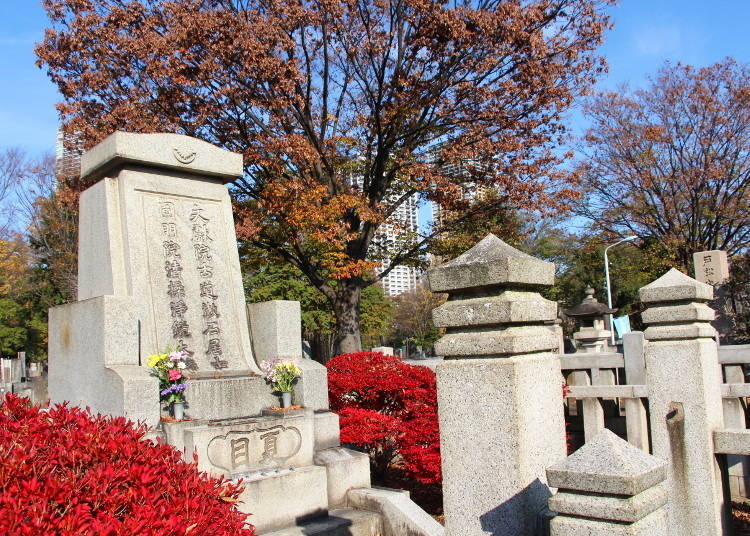
I, for one, started out with I am a Cat, Nastume Soseki’s first novel and highly amusing, sarcastic analysis of humanity, as seen through the eyes of a feline. Soon after, I devoured his other major books, from the deeply philosophical, beautiful Kokoro to the humorous Botchan – first in German and then, as my language skills improved, again in Japanese. He is my favorite fusion of two of my most favorite things: writing and Japan. As such, standing in front of his grave felt almost surreal, a bit like meeting a music or TV idol that you’re a fan of. Just much quieter, and without actual conversation. This calmness of the cemetery around me and the beautiful falling autumn foliage, though, was probably why I felt a genuine connection between me and the dead author, much like the moment I had with Lafcadio Hearn. I thought about the cat that had eyed me when I arrived early in the morning, before I had even stepped on the cemetery grounds. It is only fitting that Zoshigaya Cemetery is home to a large number of felines, and I am sure that they watch the two-legged visitors with the same curious bewilderment as the main protagonist of I am a Cat watches the humans in his life. In the classic style of Natsume Soseki, by the way, said cat isn’t very fond of humans: “Living as I do with human beings, the more that I observe them, the more I am forced to conclude that they are selfish.” (Natsume Soseki, I am a Cat)
Zoshigaya Cemetery: Discovering the Unseen
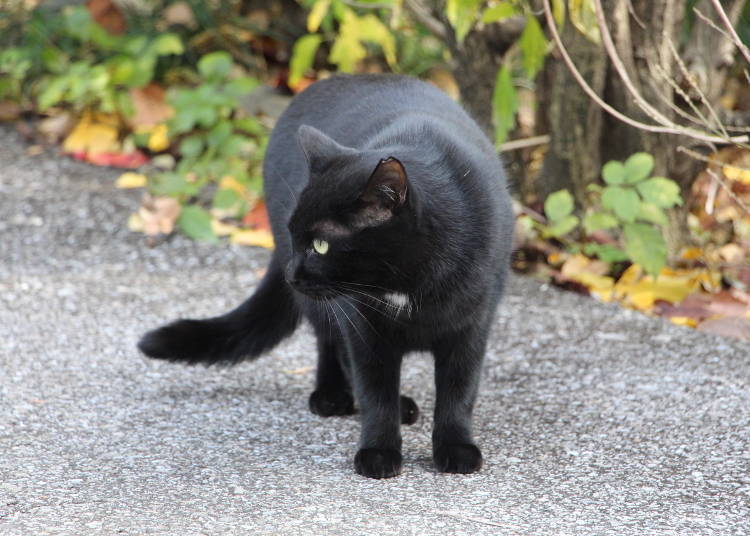
As I am writing about the experiences I made during my unique visit to Zoshigaya Cemetery, another one of Natsume Soseki’s quotes from his novel Sanshiro comes to mind: “Even bigger than Japan, surely, is the inside of your head.” I feel like this could easily be the motto of general sightseeing in Japan, because as much at it is about admiring beautiful sceneries and the likes, it is even more so about discovering the unseen. This seems especially true for Zoshigaya Cemetery, a place that certainly isn’t on the must-see list of the majority of tourists or even Tokyoites, and yet is a place that I would recommend to each and every single person dwelling in Tokyo.
Walk among the headstones, not just for the sake of discovering the most famous of the deceased but to take in Zoshigaya Cemetery’s unique atmosphere, the mewling of cats in the distance, the flapping of wings above your head – and the pleasant, natural silence that is so rare in a metropolis like Tokyo. Say a silent hello to a grave or two, bring some flowers if you feel like it or just stroll around without a care in the world. And after having been lost among trees and stones for a while, forgetting both time and whatever else uses to keep you busy, why not tell me of your own experiences and connections among the graves? I am looking forward to hear of your Zoshigaya Cemetery discoveries.
-
Zoshigaya Cemetery雑司ヶ谷霊園
- Address 4-25-1 Minamiikebukuro, Toshima 171-0022, Tokyo Prefecture
Written by:

- Area
- Category
*Prices and options mentioned are subject to change.
*Unless stated otherwise, all prices include tax.
Limited time offer: 10% discount coupons available now!
Recommended places for you
-

Tokyo Metropolitan Government
Landmarks
Shinjuku
-
Events
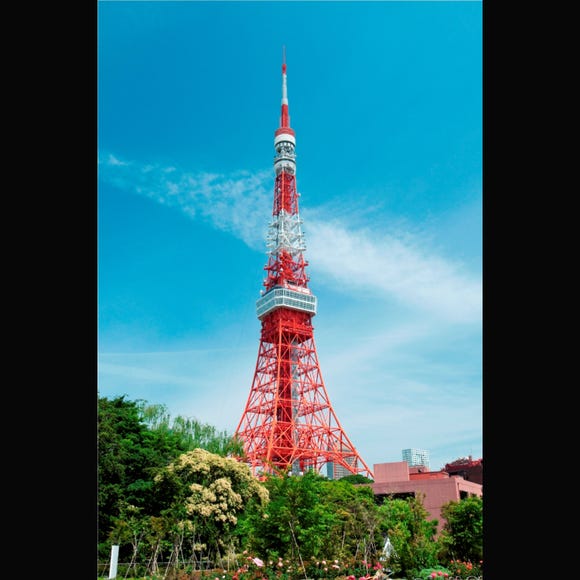
Tokyo Tower
Landmarks
Roppongi
-

Kappabashi Street
Old Towns (Shitamachi)
Asakusa
-
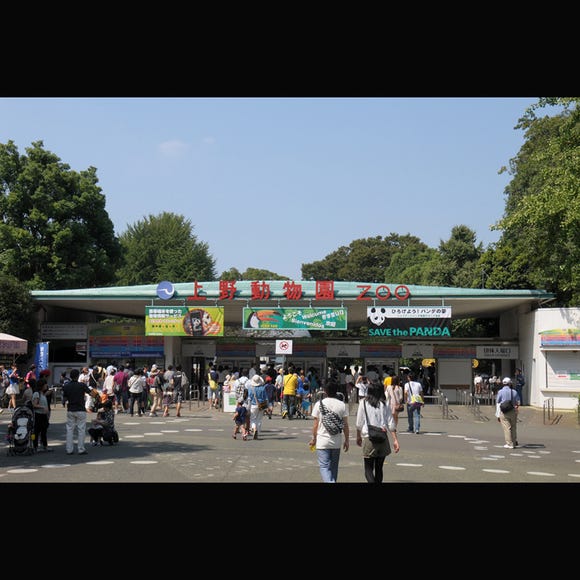
Ueno Zoo (Ueno Zoological Gardens)
Zoos, Aquariums & Botanical Gardens
Ueno
-
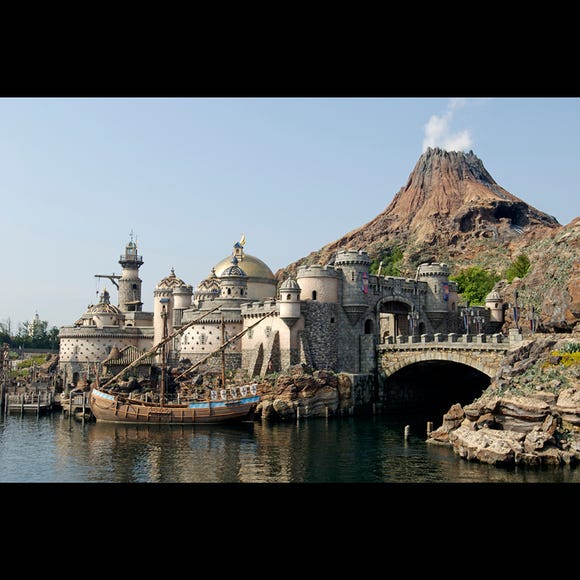
Tokyo Disney Sea®
Theme Parks
Chiba Suburbs
-
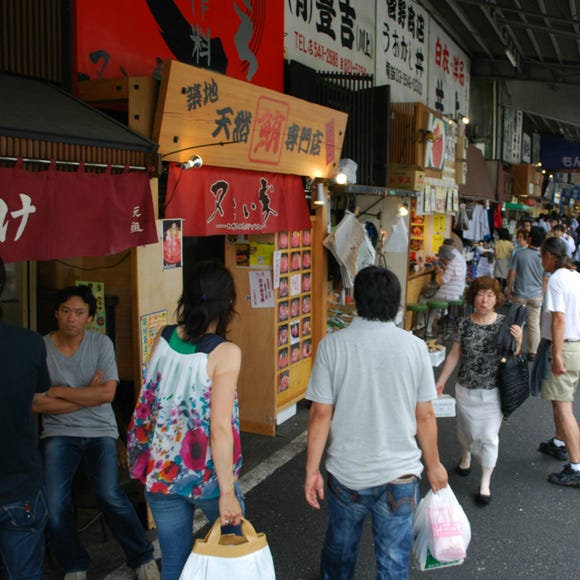
Tsukiji Outer Market
Old Towns (Shitamachi)
Tsukiji
-

12 Unique & Fun Tokyo Food Tours to Enjoy in 2024
-

A Complete Guide to the JR West Kansai Area Pass
-

The CASIO S100: How CASIO's Masterpiece Calculator Redefines Business Elegance With Japan-Made Reliability
-

15 Must-Try Restaurants in Ikebukuro: From Aged Yakiniku to All-You-Can-Eat Sushi, Plus Adorable Animal Cafés
-

Opened in Spring 2024! What to do at Tokyu Plaza Harajuku Harakado
-

Everything You Need To Know About the Kyoto-Osaka Sightseeing Pass
-
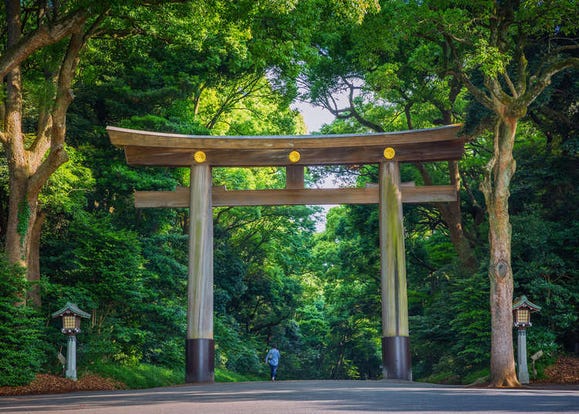
Meiji Shrine (Meiji Jingu): Exploring the Sacred Sanctuary of Peace in Bustling Tokyo
-
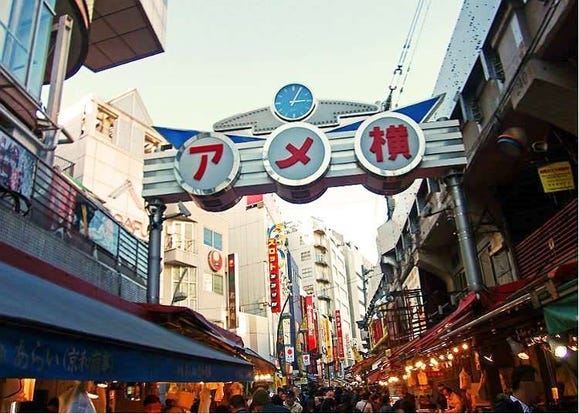
Ueno Station Area Guide: Fun Ways to Explore Tokyo's Popular Destination (Area Map & Sightseeing Tips)
-

A Visit to the Aoyama Cemetery
-
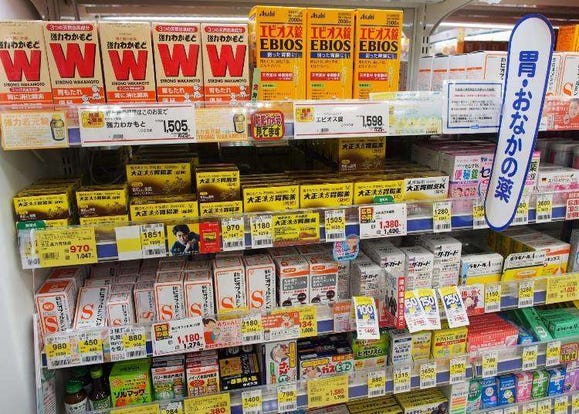
Complete Guide to Buying Japanese Medicine in Japan: Phrases and Vocabulary You Need to Know
-
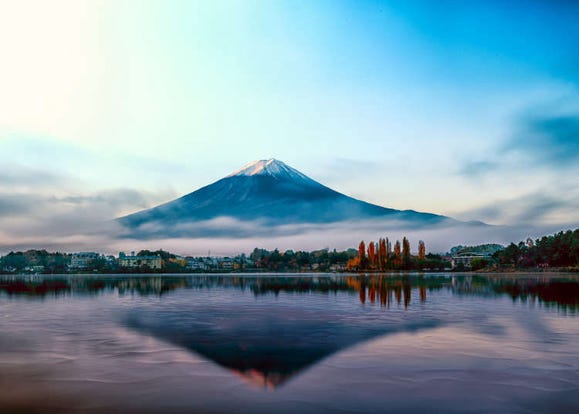
16 Secrets About Mt. Fuji, the Symbol of Japan: Even Japanese People Don’t Know That?!
-
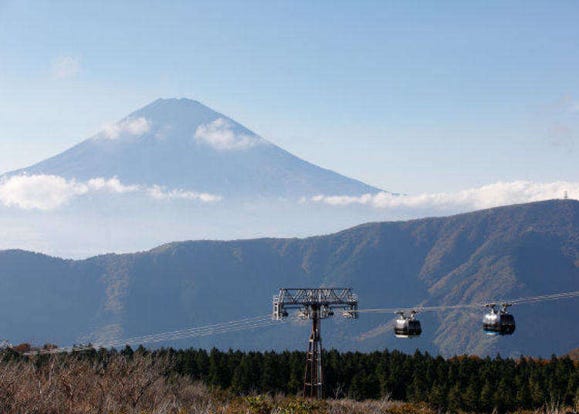
Easy Day Trip from Tokyo! Ultimate Sightseeing Guide for Hakone & Lake Ashinoko!
- #best ramen tokyo
- #what to buy in ameyoko
- #what to bring to japan
- #new years in tokyo
- #best izakaya shinjuku
- #things to do tokyo
- #japanese nail trends
- #what to do in odaiba
- #onsen tattoo friendly tokyo
- #daiso
- #best sushi ginza
- #japanese convenience store snacks
- #best yakiniku shibuya
- #japanese fashion culture
- #best japanese soft drinks












